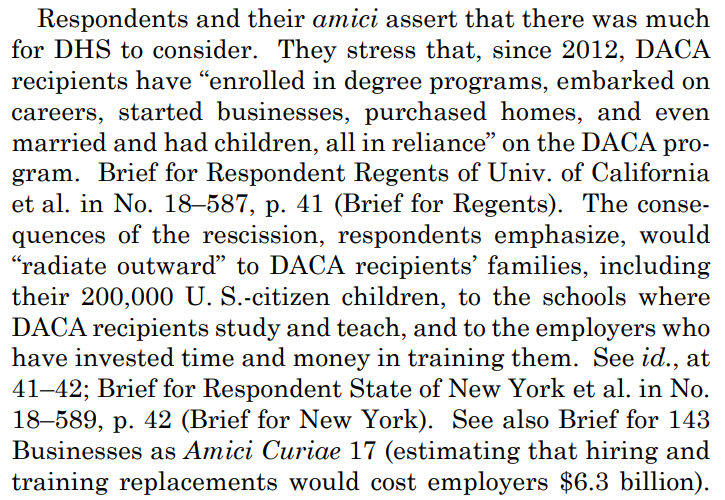Thread: Today, the United States Supreme Court ruled the Department of Homeland Security& #39;s repeal of DACA protection was "arbitrary and capricious." Here& #39;s a short breakdown of the Court& #39;s opinion. It takes us through a journey of Admin law, seat belts, and due process. 1/22.
First, what is DACA? In the Summer of 2012, DHS created the Deferred Action for Childhood Arrivals. The program "allows certain unauthorized aliens who entered the US as children to apply for a two-year forbearance of removal." ~700k have benefited from this program. 2/22.
2017: AG Jeff Sessions "advised DHS to rescind DACA, based on his conclusion that it was unlawful." This was met with legal challenges that the Acting Secretary of DHS had violated the Administrative Procedure Act (APA). 3/22.
Here& #39;s something I had totally forgotten: The Obama Admin also tried to expand DACA to apply to parents. This was called DAPA (Deferred Action for Parents of Americans and Lawful Permanent Residents). This was blocked in Court and then withdrawn by the Trump Admin. 4/22.
Three months later after withdrawal of DAPA, AG Sessions told DHS Acting Secretary Elaine Duke to "consider an orderly and efficient wind-down process [of DACA]." Ms. Duke issued a memo summarizing DACA, DAPA, and the legal challenges to same. 5/22.
"Within days of...[the] rescission announcement, multiple groups of plaintiffs" sued. This included DACA recipients, the Regents of the Univ. of Cal., and the NAACP. Core claims were that rescission was Arbitrary and Capricious and a 5th Amd. due process violation. 6/22.
[Then a lot of procedural stuff happened, but all litigation put a halt on the DHS& #39;s efforts to rescind DACA]. 7/22.
No one disputes DHS has the right to rescind DACA. "The dispute is instead primarily about the procedure the agency followed in doing so."
So, what& #39;s the procedure? Well, half-dozen readers, let me introduce you to the APA, or the Administrative Procedure Act!!! 8/22.
So, what& #39;s the procedure? Well, half-dozen readers, let me introduce you to the APA, or the Administrative Procedure Act!!! 8/22.
The APA "sets forth the procedures by which federal agencies are accountable to the public and their actions subject to review by the courts." An admin body can change a rule, but it can& #39;t be "arbitrary and capricious." 9/22.
In her memo ending DACA, Acting Sec. Duke cited to the 5th Circuit& #39;s holding that DAPA "conflicted with the discretion authorized by Congress" because DAPA gave government benefits. But what wasn& #39;t said is more important. 10/22.
Duke& #39;s memo, nor AG Sessions& #39; letter to her, "addressed the forbearance policy at the heart of DACA nor compelled DHS to abandon that policy." There was nothing in Duke& #39;s memo that justified ending Deferred Action. 11/22.
The Roberts& #39; Hammer: "She instead treated the Attorney General& #39;s conclusion regarding the illegality of benefits as sufficient to rescind both benefits AND FORBEARANCE, without explanation." (emphasis added). 12/22.
And this is where a ruling on seat belts is instructive. In 1982, the Natl. Hwy Traffic Safety Admin (NHTSA) required cars made after 1982 to have airbags or seatbelts. 4 yrs. later, NHTA decided auto-seatbelts wouldn& #39;t be effective, so they repealed the entire rule(!!!) 13/22.
The Supreme Court concluded a total rescission was arbitrary and capricious. And "[w]hile the factual setting is different here, the error is the same. Even if it is illegal for DHS to [expand gov& #39;t benefits]," it had nothing to do with the principles behind forbearance. 14/22.
Here, DHS tried to throw the baby out with the bathwater: "[t]he fact that there may be a valid reason not to separate deferred action from benefits does not establish that DHS considered that option or that such consideration was unnecessary." 15/22.
There was also a Fifth Amendment Due Process challenge, but this argument failed. The Gov& #39;t.& #39;s actions, including Trump& #39;s statements about Latinos, did not "raise a plausible inference that [DHS& #39;s decision] was motivated by animus." 16/22.
Chief Justice Roberts reaffirms his "balls and strikes" approach: "We do not decide whether DACA or its rescission are sound policies." Instead, they only address whether DHS provided a reasonable explanation for their DACA rescission. They conclude DHS made 2 mistakes: 17/22.
DHS "failed to consider the conspicuous issues of whether to retain forbearance and what if anything to do about the hardship to DACA recipients." The Court doubts the agency "appreciated the scope of its discretion or exercised that discretion in a reasonable manner." 18/22.
So is it a total victory for DACA recipients? Not by a long shot. The Court held "[t]he appropriate recourse is therefore to remand to DHS so that it may consider the problem anew." For someone determined to reverse DACA, this opinion is a road map. 19/22.
While DACA recipients remain at the mercy of the political will of the times, consider the following impacts DACA recipients have had on the American economy, as noted by Chief Justice Roberts: 20/22.
So that& #39;s it. Thanks for reading! Special thanks to Prof. Eads for insisting that we take Admin Law. Extra special shout-out to @nathancortez for being a great Admin Law professor. 22/22.

 Read on Twitter
Read on Twitter



